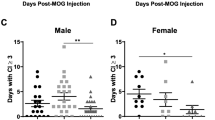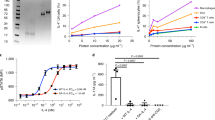Abstract
Background
We previously demonstrated the local production of the pleiotropic cytokine interleukin-6 (IL-6) in the central nervous system (CNS) in experimental autoimmune encephalomyelitis (EAE), an animal model for the human disease multiple sclerosis.
Materials and Methods
To assess the role of IL-6 in autoimmune CNS inflammation, we administered neutralizing antibodies to IL-6 in the EAE model. Their effect was examined at the clinical and histopathological level. Levels of administered antibody and IL-6 bioactivity were followed in serum and cerebrospinal fluid (CSF).
Results
Systemically administered antibodies penetrated into the fluid CSF in animals in which EAE was induced. Administration of anti-IL-6 reduced the development of actively induced as well as adoptively transferred EAE and was associated with increased levels of IL-6 activity in the CSF and to a lesser extent in the serum. Anti-IL-6 was still effective when given 1 day before the onset of disease signs in adoptively transferred EAE. The disease-reducing effect of anti-IL-6 was also reflected at the pathological level by the absence of inflammatory infiltrates in the CNS.
Conclusions
Our study indicates that IL-6 plays an important role in autoimmune CNS inflammation. However, due to the complex nature of the in vivo interactions of administered antibodies, the disease-reducing effect of the anti-IL-6 antibodies could be caused by neutralization of IL-6 activity or by enhancement of IL-6 activity via induction of higher IL-6 levels in the CNS.




Similar content being viewed by others
References
Akira S, Taga T, Kishimoto T. (1993) Interleukin-6 in biology and medicine. Adv. Immunol. 54: 1–78.
Frei K, Leist TP, Meager A, et al. (1988) Production of B cell stimulatory factor-2 and interferon γ in the central nervous system during viral meningitis and encephalitis. J. Exp. Med. 168: 449–453.
Houssiau FA, Bukasa K, Sindic CJM, Van Damme J, Van Snick J. (1988) Elevated levels of the 26K human hybridoma growth factor (interleukin 6) in cerebrospinal fluid of patients with acute infection of the central nervous system. Clin. Exp. Immunol. 71: 320–323.
Frei K, Malipiero UV, Leist TP, Zinkernagel RM, Schwab ME, Fontana A. (1989) On the cellular source and function of interleukin 6 produced in the central nervous system in viral diseases. Eur. J. Immunol. 19: 689–694.
Nishimoto N, Yoshizaki K, Eiraku N, et al. (1990) Elevated levels of interleukin-6 in serum and cerebrospinal fluid of HTLV-I associated myelopathy/tropical spastic paraparesis. J. Neurol. Sci. 97: 183–193.
Houssiau FA, Devogelaer J-P, Van Damme J, Nagant de Deuxchaisnes C, Van Snick J. (1988) Interleukin-6 in synovial fluid of patients with rheumatoid arthritis and other inflammatory arthritides. Arthritis Rheum. 31: 784–788.
Swaak AJG, Van Rooyen A, Aarden LA. (1989) Interleukin-6 (IL-6) and acute phase proteins in the disease course of patients with systemic lupus erythematosus. Rheumatol. Int. 8: 263–268.
Hauser SL, Doolittle TH, Lincoln R, Brown RH, Dinarello CA. (1990) Cytokine accumulations in CSF of multiple sclerosis patients: Frequent detection of interleukin-1 and tumor necrosis factor but not interleukin-6. Neurology 40: 1735–1739.
Maimone D, Gregory S, Arnason BGW, Reder AT. (1991) Cytokine levels in the cerebrospinal fluid and serum of patients with multiple sclerosis. J. Neuroimmunol. 32: 67–74.
Frei K, Fredrikson S, Fontana A, Link H. (1991) Interleukin-6 is elevated in plasma in multiple sclerosis. J. Neuroimmunol. 31: 147–153.
Gijbels K, Van Damme J, Proost P, Put W, Carton H, Billiau A. (1990) Interleukin 6 production in the central nervous system during experimental autoimmune encephalomyelitis. Eur. J. Immunol. 20: 233–235.
Gijbels K, Van Damme J, Billiau A. (1990) Detection of production of interleukin-6, but not of tumor necrosis factor or interferon during experimental autoimmune encephalomyelitis. In: Romagnani S, Abbas AK (ed). Cytokines: Basic Principles and Clinical Applications. Serono Symposia Publications, Raven Press, New York, Vol. 68, p. 67.
Maimone D, Annunziata P, Salvadori C, Malamdrini A, Guazzi GC. (1993) IL-6 detection in multiple sclerosis brain. Neurology 43(Suppl 2): A162.
Gijbels K, Billiau A. (1992) Interleukin 6: General biological properties and possible role in the neural and endocrine systems. Adv. Neuroimmunol. 2: 83–97.
Brocke S, Gijbels K, Steinman L. (1994) Experimental autoimmune encephalomyelitis in the mouse. In: Cohen IR, Miller AR (eds). Animal Models for Autoimmune Diseases: A Guidebook. Academic Press, Orlando, pp. 1–14.
Starnes HF, Pearce MK, Tewari A, Yim JH, Zou J-C, Abrams JS. (1990) Anti-IL-6 monoclonal antibodies protect against lethal Escherichia coli infection and lethal tumor necrosis factor-α challenge in mice. J. Immunol. 145: 4185–4191.
Cherwinski H, Schumacher JH, Brown K, Mosmann TR. (1987) Two types of mouse helper T cell clone: III. Further differences in lymphokine synthesis between Th1 and Th2 clones revealed by RNA hybridization, functionally monospecific bioassays, and monoclonal antibodies. J. Exp. Med. 166: 1229–1244.
Glantz SA. (1992) Pimer of Biostatistics. 3rd Ed. McGraw-Hill, New York.
Billiau A, Heremans H, Vandekerckhove F, et al. (1988) Enhancement of experimental allergic encephalomyelitis in mice by antibodies against IFN-γ. J. Immunol. 140: 1506–1510.
Black WJ, Munoz JJ, Peacock MG, et al. (1988) ADP-ribosyltransferase activity of pertussis toxin: Immunomodulation by B. pertussis. Science 240: 656–659.
Campbell IL, Kay TW, Oxbrow L, Harrison LC. (1991) Essential role for interferon-gamma and interleukin-6 in autoimmune insulin-dependent diabetes in NOD/Wehi mice. J. Clin. Invest. 87: 739–742.
Finck BK, Chan B, Wofsy D. (1994). Interleukin 6 promotes murine lupus in NZB/NZW F1 mice. J. Clin. Invest. 94: 585–591.
Libert C, Vink A, Coulie P, et al. (1992) Limited involvement of interleukin-6 in the pathogenesis of lethal septic shock as revealed by the effect of monoclonal antibodies against interleukin-6 or its receptor in various murine models. Eur. J. Immunol. 22: 2625–2630.
Heremans H, Dillen C, Put W, Van Damme J, Billiau A. (1992) Protective effect of anti-interleukin (IL)-6 antibody against endotoxin, associated with paradoxically increased IL-6 levels. Eur. J. Immunol. 22: 2395–2401.
Hunter CA, Abrams JS, Beaman MH, Remington JS. (1993) Cytokine mRNA in the central nervous system of SCID mice infected with Toxoplasma gondii: Importance of T-cell-independent regulation of resistance to T. gondii. Infect. Immun. 61: 4038–4044.
Suzuki Y, Yang Q, Conley FK, Abrams JS, Remington JS. (1994) Antibody against interleukin-6 reduces inflammation and numbers of cysts in brains of mice with toxoplasmic encephalitis. Infect. Immun. 62: 2773–2778.
May LT, Neta R, Moldawer LL, Kenney JS, Patel K, Sehgal PB. (1993) Antibodies chaperone circulating IL-6. Paradoxical effects of anti-IL-6 “neutralizing” antibodies in vivo. J. Immunol. 151: 3225–3236.
Lu ZY, Brochier J, Wijdenes J, Brailly H, Bataille R, Klein B. (1992) High amounts of circulating interleukin (IL)-6 in the form of monomeric immune complexes during anti-IL-6 therapy. Towards a new methodology for measuring overall cytokine production in vivo. Eur. J. Immunol. 22: 2819–2824.
Martens E, Dillen C, Put W, Heremans H, Van Damme J, Billiau A. (1993) Increased circulating interleukin-6 (IL-6) activity in endotoxin-challenged mice pretreated with anti-IL-6 antibody is due to IL-6 accumulated in antigen-antibody complexes. Eur. J. Immunol. 23: 2026–2029.
Steinman L. (1993) Autoimmune disease. Sci. Am. 269: 106–114.
Hunter CA, Jennings FW, Kennedy PGE, Murray M. (1992) Astrocyte activation correlates with cytokine production in central nervous system of Trypanosoma brucei brucei-infected mice. Lab. Invest. 67: 635–642.
Yan HQ, Alcaros Banos M, Herregodts P, Hooghe R, Hooghe-Peeters EL. (1992) Expression of interleukin (IL)-1b, IL-6 and their respective receptors in the normal rat brain and after injury. Eur. J. Immunol. 22: 2963–2971.
Mihara M, Koishihara Y, Fukui H, Yasukawa K, Ohsugi Y. (1991) Murine anti-human IL-6 monoclonal antibody prolongs the half-life in circulating blood and thus prolongs the bioactivity of human IL-6 in mice. Immunology 74: 55–59.
Finkelman FD, Madden KB, Morris SC, et al. (1993) Anti-cytokine antibodies as carrier proteins. Prolongation of in vivo effects of exogenous cytokines by injection of cytokine-anti-cytokine antibody complexes. J. Immunol. 151: 1235–1244.
Campbell IL, Abraham CR, Masliah E, et al. (1993) Neurologic disease induced in transgenic mice by cerebral overexpression of interleukin 6. Proc. Natl. Acad. Sci. U.S.A. 90: 10061–10065.
Acknowledgments
This work was supported by the National Institutes of Health (NS18235) and by contributions from the Mendell Family, Hyman Abadi, the Fahnstock Family, and the Phil N. Allen Trust. DNAX is supported by Shering-Plough. KG was supported by the Belgian National Fund for Scientific Research (NFWO). The authors would like to thank A. Billiau (Leuven, Belgium) for helpful discussion.
Author information
Authors and Affiliations
Additional information
Contributed by I. Weissman on July 26, 1995.
Rights and permissions
About this article
Cite this article
Gijbels, K., Brocke, S., Abrams, J.S. et al. Administration of Neutralizing Antibodies to Interleukin-6 (IL-6) Reduces Experimental Autoimmune Encephalomyelitis and Is Associated with Elevated Levels of IL-6 Bioactivity in Central Nervous System and Circulation. Mol Med 1, 795–805 (1995). https://doi.org/10.1007/BF03401894
Published:
Issue Date:
DOI: https://doi.org/10.1007/BF03401894




